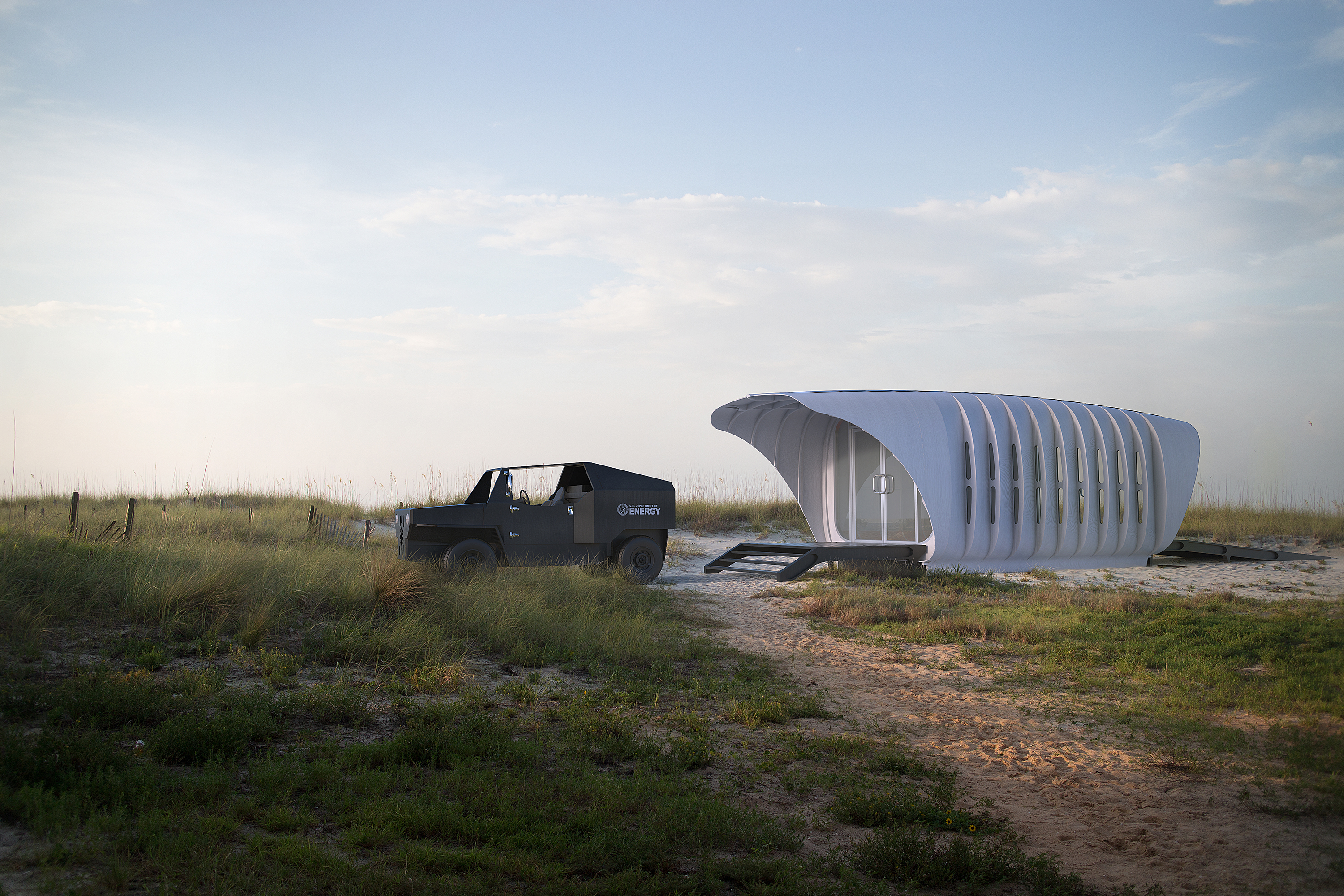Line Shape Space Ι Jan. 21, 2016
They’re the twin pillars of the American dream and the current climate predicament: the single family detached house and the automobile—the convenience, freedom, and independence enabled by inefficient and finite fossil fuels.
As such, much of the urban-planning and architecture industries are focused on ways to radically subvert this inherited infrastructural wisdom. So what if the best way to reform the residential-transit complex is not to discard existing models in favor of mass transit and dense high-rises, but instead simply to change the relationship between homes and cars using integrated energy systems?
That’s the supposition made by Additive Manufacturing Integrated Energy (AMIE) demonstration project, a collaboration among the Department of Energy’s Oak Ridge National Laboratory (ORNL) in Tennessee, the Chicago office of SOM, and 19 other partners. AMIE 1.0 pairs up ORNL’s hybrid natural gas/electric car with a 210-square-foot structure that both generate and share power with each other.
Both 3D-printed, the structure and vehicle use a wireless coupling station to move electricity, with 85 percent efficiency. The structure’s roof is coated in thin photovoltaic panels, which it can use to power the building and recharge the car’s battery. The car’s engine is electric, but its battery can be charged with an onboard natural gas generator. Excess power from the car can be sent to the structure’s battery to power it when sunlight isn’t sufficient.
Even the most seasoned megacommuter’s car is active for only a few hours at a time, and AMIE looks to make vehicles and buildings work together all day. “It’s a shame that these vehicles are sitting around, oftentimes not doing anything, or are using energy and doing it in a way that is totally expendable rather than recyclable,” says Brian Lee, a design partner with SOM.
The structure (which contains a kitchenette and a fold-out Murphy bed) is made up of a series of brilliant-white vaguely biomorphic ribs, tied together with post-tensioned steel rods. Each rib features gill-like windows that are hidden from view as you approach from the rear of the structure but visible from the entrance—transparent or opaque depending on which direction you face.
The structure’s insulation system is a modular vacuum-sealed foam board called modified atmospheric insulation. It’s extremely efficient, only an inch thick, and flexible enough to slot into the structure’s curved geometry. The entire wall system integrates all its structural, façade, and insulation systems into one component: sections of 3D-printed resin—only two inches thick—reinforced with carbon fiber.
The chassis of the car is made from the same material. Oak Ridge National Laboratory’s Roderick Jackson says that the use of 3D printing allowed his team to integrate material around these groundbreaking energy-sharing systems at hyperspeed. From conception to execution, the entire project took only one year.
As the first project of its type, AMIE answers a few questions only deep, open-ended research would ever think to ask: What if your car was also an on-site energy generator? What if your house could charge your car’s battery? And what if you could replace some of the output of a dirty, fossil-fuel-fired power plant by buying a new car?
But in many ways, AMIE is a conservative, incrementalist way to reform transit and housing infrastructure. It doesn’t question the supremacy of detached homes or of private automobiles. And because users are now dependent on fossil-fuel-aided vehicles to power their homes, it entrenches these two infrastructure models together into a new (albeit more efficient) economic relationship.
Lee and Jackson both say that AMIE is not meant as a definitive solution to mitigating climate change and carbon emissions. “We never said that this is the way we should [be] 3D printing single-family houses and potentially cars,” Lee says. “The whole idea is to demonstrate issues of energy and how you can move [it] around.” It’s intended as exploratory research with future iterations that could be wildly different. Lee, for example, says he’d like to see this technology deployed in a more urban model. If a small structure and car can power each other, can a subway train team up with a high-rise?
The most important innovation from AMIE is intermodal power sharing across transit and residential infrastructure, not the specific forms that transit and building take. “Using a car and using a structure was one convenient way to describe it,” Lee says.
If you take this abstract-sharing concept and apply it to infrastructure patterns seen every day, it becomes intuitive for the public to understand. “We’re trying to paint a picture of what could be, but we’re still operating within the realm of what exists today,” Jackson says. “Cars are still here, and [leveraging] existing infrastructure is something we wanted to do.”
The burly black SUV and narrow, trailer-shaped structure make it look like you could hitch it up, “tow it around, and deal with the apocalypse,” says Lee, but it doesn’t actually work like this. That said, invoking the “end times” isn’t too far a stretch from what this technology could be used for. Jackson says he’s interested in seeing how the grid-independent AMIE could help survivors of natural disasters, to say nothing of the many millions of people with no access to a power grid, ever. And if an army of AMIEs—engineered and built for peak surge—was used at mass scale during high-electricity-consumption hours, it could preclude more coal- and nuclear-powered generation plants from being built.
But in a year when the first Mad Max film in 30 years slammed into theaters with reckless and profitable abandon, AMIE looks equally like a serene technological convenience and something you might retreat to in an epic calamity. Although AMIE 1.0 has the sleek curves of an Apple product and an induction oven, in case of total societal collapse, AMIE’s end-times progeny would more likely sport gun-racks and ramrod spikes. As open-ended iterative research, Jackson and Lee say AMIE 2.0 could be a completely different animal.
